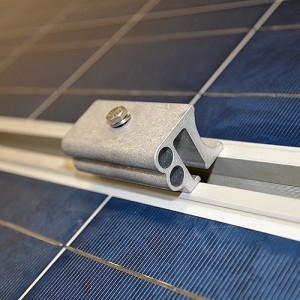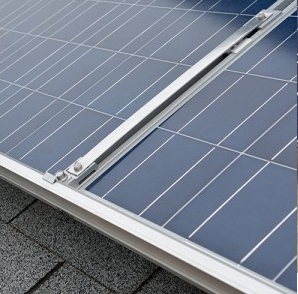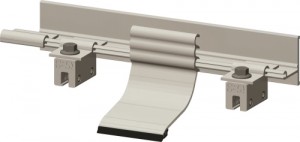See also: The best time to think about snow retention on solar roofs is before it even snows

Solar Snow Pad by Alpine SnowGuards
The average solar panel can support a snow load of about 800 lbs. In snowy areas, that’s great, except for one thing: Solar panels have a frictionless surface, and they often release piled-up snow all at once. The result is a rooftop avalanche. The sudden snow slide can cause damage to property and injury to people.
Several companies offer products for snow management – some specifically for solar arrays, others for roofs in general. Alpine SnowGuards, the sister company of EcoFasten Solar, for example, has a system that clamps to panel frames.
The Solar Snow Pad allows snow and ice to build up, slump and slowly slide off a panel’s surface in an orderly fashion. The device uses a “T” nut clamp that will fit between panels as close together as 1/8 in. Solar Snow Pads measure 1 ¼ in. off the roof surface to prevent shading.
The company also produces the Solar SnowMax, which attaches to a panel frame. It functions as a snow retention barricade on landscape- or portrait-oriented panels. It’s limited for use in areas with 50-lbs./sq. ft. or less snow load. Heavier snow could damage a frame.

Solar SnowMax by Alpine SnowGuards
In some cases, a panel-mounted snow management system may not be enough. A barricade or fence system, several inches high and mounted toward the edge of a roof, may be needed. Alpine SnowGuards also offers a modification for its Snow Pad that creates a fence-like structure with 3/8-inch rods running along a panel.
Other companies produce snow-retention products too.
ColorGard by S-5!
ColorGard controls snow migration while maintaining the appearance of a roof with color and finish matching. ColorGard’s penetration-free clamp attachment preserves the roof manufacturer’s warranty.
SnowBreaker by SnoBlox
SnowBreaker is recommended for use with PV panels. It breaks snow and ice into safer, smaller pieces while still letting it come off panels. It can be installed mechanically or with adhesives.
Snow Fence by Rocky Mountain Snow Guards
While Snow Fence is not a true “solar snow guard,” fences like this have proven effective for snow management, as long as the contractor leaves a minimum of 18 to 24 in. of edge exposed at the eave.







I am new to solar panels and found this site when I searched ‘solar panel avalanche’. It’s real, and it’s scary. When it comes flying down, god help anyone standing there. I wonder how the home owner’s insurance companies feel about this.
Have 20 panels, and I live in a snow area and the installer never mentioned the need for snow guards. I definitely need them, as the snow slides off and large quantities and it is definitely dangerous. I’m pricing stuff now. But it seems to me it would or should be a legal requirement for companies that install solar panels to suggest snow guards at the time of installation to preclude any damage or harm. In everything I read about solar panels prior to purchase the need for snow guards never came up. And it never entered my mind having no prior experience or knowing anyone that already had them.
I agree. This never occurred to me until After the first big snow storm and I could hear the snow flying off of the roof. My toddler likes to play in the front yard, so I have to keep him away from the house and I get nervous even going out the front door. Let me know what you come up with Dan.
100% agree. I’ve been fighting with my solar installation company, but they won’t do anything for me. They need to advise people of this. Now I have the problem and can’t afford to fix it!
I’m in the same boat as you guys. my roof is 20 ft up, and a “solavalanche” once destroyed my backyard furniture. It absolutely could kill someone if they happened to be outside at the time. I had a lawyer write to the solar company, but like Stephanie says, they refuse to take any responsibility. If significant damage is done by another incident, I’ll definitely sue them. They never warned me about this potential.
I agree with Nick, Stephanie, and Jonah; our solar company never told us about the solar guards because,” if he had, it would’ve raised the cost and you might not have gone with us…” straight from the owner’s mouth! I couldn’t believe he said that to me and he wouldn’t do anything for us i.e., take off $100 to install solar guards which they do have; nothing; I wouldn’t ever go with this company again. I told him it’s a lawsuit waiting to happen and he didn’t care… I’m certainly not paying them $1000 for solar guards now!
Been looking at a roof rake, but these can cause damage if you’re not careful, and are tedious.
Anyone find any solar guards that are good and reasonable? Let me know. Best to all…
NextStep Electric Inc. has a panel warming system that ends the need for a snow fence to stop Avalanching. They have a snow melting system that works in -40 below conditions and are just starting to market this in the northeast of the United States. Their sales have just started this week. This is an easy to use, retrofit solution, that can melt up to 5lbs of ice/snow per sqft. in just 3 hrs. It is a peel and stick solution that instals in under 5 minutes.
For more information contact me at osiris@nextstepelectric.com.
Osiris
Now here I was thinking that we wanted to get the snow off the PV modules as soon as possible so they could get back to making energy. But now we are installing devices designed to make sure the snow stays on the modules preventing energy production until the spring thaw.
One could look at it like that. However, one could also see this as an opportunity to grow the industry by meeting a need of the customer. Roofers all across America can now tap into the solar industry to drive revenue. Try not to be so grim. Unless you have solar panels in a snow region you will never understand how much customers would appreciate the guards. Try to get informed before making off the cuff statements. It’s hard to see why 3 people upvoted your post. It is lacking of an understanding of the basic elements to the usage of solar guards.